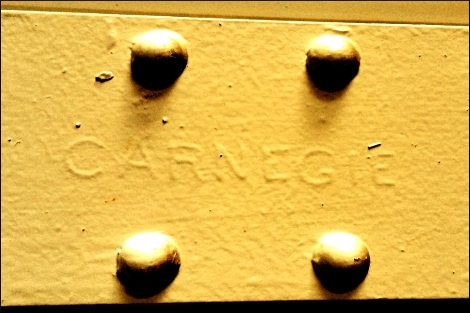 If you look carefully at the structural steel in the oldest of those magnificent Romanesque buildings at the Mill Square redevelopment, you'll see Andrew Carnegie's maker's mark.
If you look carefully at the structural steel in the oldest of those magnificent Romanesque buildings at the Mill Square redevelopment, you'll see Andrew Carnegie's maker's mark.
Francis Hector Clergue used the American robber baron's Carnegie Steel in the initial buildings of his new pulp mill.
Clergue, as every Saultite knows, was the lawyer from Bangor, Maine who came here in 1894 on behalf of a group of Philadelphia capitalists looking for investment opportunities.
He founded St. Marys Paper, what is now Essar Steel Algoma, and Algoma Central Railway, all in just eight years from 1895 to 1902.
Other buildings at the St. Marys Paper/ Mill Square site were built with Clergue's Algoma Steel after the first local ingot was cast in 1902.
Glen Martin sees a ton of significance and symbolism in Clergue's switch to homegrown Algoma Steel.
Martin is the hirsute Los Angeles-based Saultite who was the initial driving force behind the Sault Ste. Marie Solar Park before the project was acquired by Starwood Energy in 2010.
He's also the founder and chief executive officer of Energizing Company, a California startup that's planning to deploy its flagship utility-distributed microgrid project here in Sault Ste. Marie.
In recent months, Martin has been thinking a lot about the history of his hometown.
He shot the above photo in the former St. Marys Paper general administration building and showed it during his presentation at last week's Energy Opportunities Conference, organized at Algoma's Water Tower Inn by the Sault Ste. Marie Innovation Centre.
He juxtaposed this image with one shown below of an Algoma Steel girder in the former St. Marys pulp tower.
 "It marked a symbolic transition," Martin says.
"It marked a symbolic transition," Martin says.
The birth of Algoma Steel was indeed an important juncture in the industrial histories of both Sault Ste. Marie and Canada.
"My feeling was that Clergue believed he could be as powerful as Carnegie, Rockefeller, Ford, et al because of the wealth of opportunity that the Sault offered," Martin tells SooToday.com.
The more Martin learns about Francis Clergue, the more he's convinced that the Sault should be called Clerguesville.
In terms of industrial development, the Sault really wasn't much of anything before Clergue showed up here.
For much of our history, we were a minor-league fur trading post.
More furs moved through Michipicoten than the Sault.
Local prospects were boosted by the opening of the U.S. ship canal in 1855 and the arrival in 1887 of a branch line of the Canadian Pacific Railway from Sudbury, as well the completion of the International Rail Bridge that same year.
But as Martin reads our local history, it wasn't steel that built the Sault.
It wasn't paper, either.
And it wasn't our connecting to the national rail transportation network.
According to Martin, it was electricity.
Francis Hector Clergue's first big project here, orchestrated from the famous blockhouse that's now a national historic site, was the Tagona Water and Light Company.
He learned soon after his arrival that there was a very significant height difference between the two ends of the St. Marys River rapids,
We were naturally gifted with 27 vertical feet of what engineers refer to as "hydraulic head" - essential to generation of hydroelectric power.
Clergue wasn't the first to see this potential.
In fact, there was already an unfinished power plant here.
All Clergue did to drop-kick the Sault into the industrial era was to buy that operation out of receivership, complete the project and convince the city to grant him a 20-year exclusive franchise for water and electricity.
Clergue was a brilliant visionary and promoter.
He was rather less brilliant at execution, though.
Complaints about power failures and poor water quality were so common during his 20-year deal that as the expiry date approached, city councillors decided against renewing and Clergue was forced to sell his operation to a new municipally owned water and light utility.
The result was the Sault Ste. Marie PUC, born (some today might think ironically) in a deluge of brownouts and brown water.
Clergue soon ran into cash-flow problems with the other pillars of his local industrial empire.
By September 1903 he wasn't able to meet payroll or daily operating expenses and hundreds of angry unpaid workers gathered outside what's now the Algoma Conservatory of Music.
Every window in the building was broken, workers stormed inside and trashed the place, the mayor read the riot act and no one paid him an ounce of attention.
"The story ends in the way that all Canadian stories end," Martin told his Sault audience last week. "The militia arrives and puts law and order back in place."
Clergue was pushed out, his company reorganized, his assets recapitalized.
He came back to the Sault on just two occasions - for events that honoured his considerable contributions to this area.
"There was a lot of support for him,” Martin said. “The Philadelphia money poured into this community. They developed very large and substantial industrial assets. But with all good things, his eagerness to expand rapidly, he did run into some cash-flow problems.”
"Clergue drove the Sault very rapidly, very aggressively. He flew a little close to the sun and ended up flaming out. Many of these industrial assets continue to be the most influential employers in town. The paper mill has since ceased operation but is right now in the midst of a restorative development effort. The steel mill is doing well. The rail assets have been sold by Algoma Central Railway but they do continue to operate."
"It was just a daisy chain of innovations that happened here in city of Sault Ste. Marie based upon this one power station that he developed."
Clergue's Sault hydroelectric plant was the anchor of his empire, Martin said.
The Bangor lawyer hoped that if he built it, they would come.
They didn't.
There was no race to the Sault to establish new industrial enterprises to buy Clergue's power.
He was looking for industrial offtake customers and when they didn't materialize, he decided to create them himself.
"So he started a chain of events that led to the industrialization of Sault Ste. Marie in a way that no one else could have. Only he could have done this at the time," Martin said.
"The history of Sault Ste. Marie is built on the foundation of hydroelectricity. In those days, hydro was considered the gold standard of energy development. It was clean. It was abundant. It was something that, in the Great Lakes and St. Lawrence regions, was foundational."
And once again in our day, Martin said, power appears to be foundational to the future of Sault Ste. Marie, with some important twists.
Proclaiming itself as the alternative energy capital of North America, the Sault has been very busy adding wind farms, Martin's solar project, biomass capability, industrial cogeneration, waste energy and other renewable energy assets.
"All of these are allowing Sault Ste. Marie with its relatively small load to be able to brag that it is 100 percent renewable energy that is powering Sault Ste. Marie. Clean, reliable, high-quality," Martin said.
Indeed, power is no longer considered just a commodity.
Quality of electrical generation can be as important as quantity.
For example, data centres, one of the biggest job-creators in the IT sector these days, look very closely at power quality and reliability when selecting new locations.
"The Sault's power quality, based on solid-state inverters, is such that the frequency regulation is extraordinarily attractive to certain types of indusries that require high-quality power," Martin said.
"It's local production of power. It's not piped in from far away. And lastly, it's resilient. Insofar that there's a severe weather event, Sault Ste. Marie today is well-positioned to weather that event."
"Energy development, energy projects, energy generating assets are not the end goal of the initiatives that we should be looking for here in Sault Ste. Marie," Martin said. "They're merely the foundation. They are the starting point. If we had a well-established generating source here, there are certain types of industries around the world that seek out this type of footprint for location of their services. One small example is, some of the data centres stateside, which are one of the largest-growing IT-sector components of the economy. They seek to locate data centres in locations like Sault Ste. Marie where there's a tremendous amount of clean energy with high quality, with reliability."
As successful as the Sault’s commitment to high-quality, renewable energy has been, we may have quite unintentionally stumbled into something much, much bigger.
"I think Sault Ste. Marie is going to be very well positioned here to move into the next several decades with a foundation of clean energy projects and innovation in and around those things," Martin says.
"We believe strongly that the economies will be relocalizing. That the centralized grid, the centralized distribution of food or manufactured product, through the certain things that are happening (IT technologies, 3-D printing), through radical shift in the way that the manufacuring economy is structured, will be relocalizing."
That belief is behind Martin's recent sponsorship of the recent Grist at the Mill event at the Mill Market, a kind of summit meeting that invited makers from across North America and Asia to come to the Sault to meet their counterparts and compare how web marketing and e-commerce can help tiny manufacturers in the North connect with customers and compete successfully.
"And thus," Martin said, "potentially reversing a little bit of the flow from northern communities like Sault Ste. Marie down to the Torontos, Vancouvers, Montreals and frankly even the Los Angeles of the world."
The Sault has used electricity to supercharge its economy in the past.
Can we do it again?